
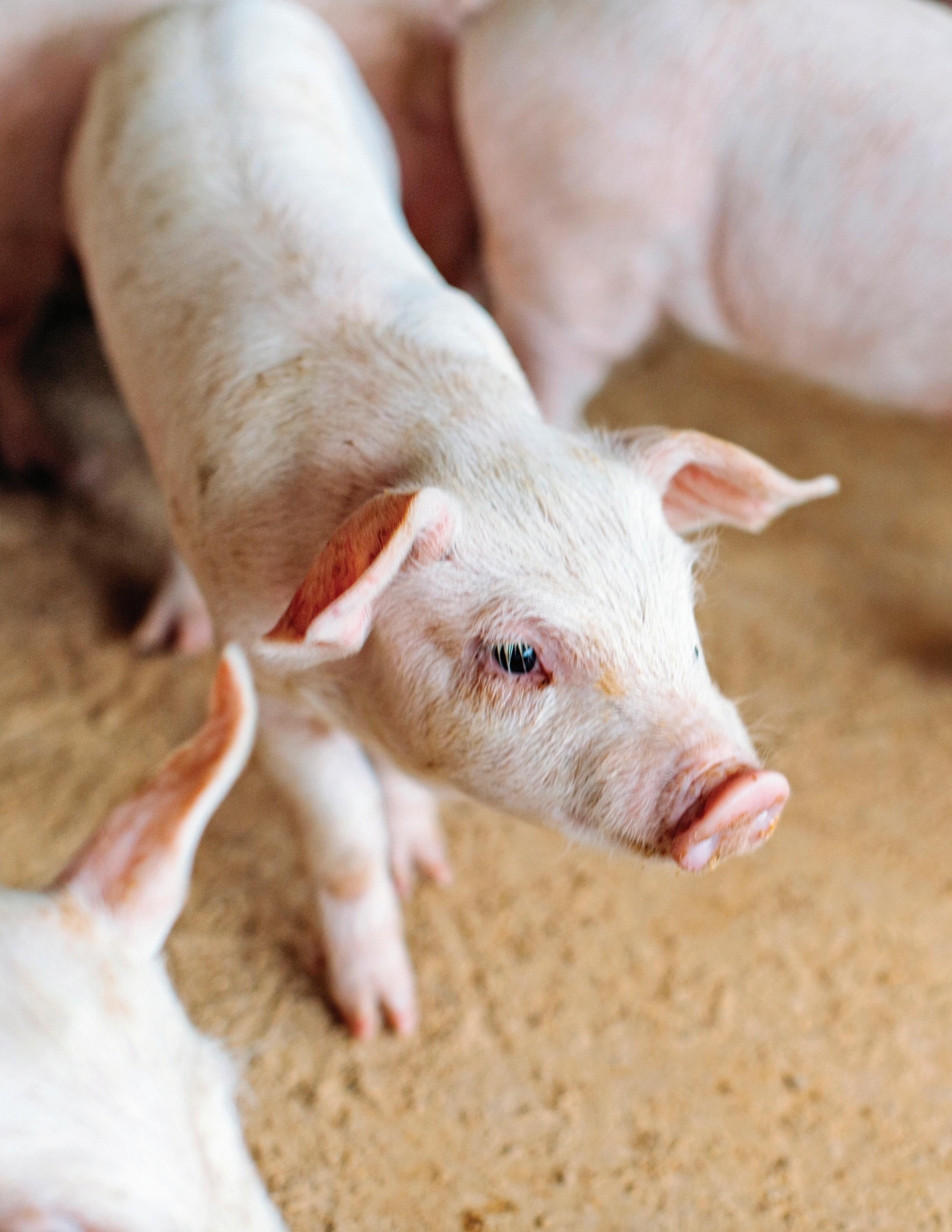







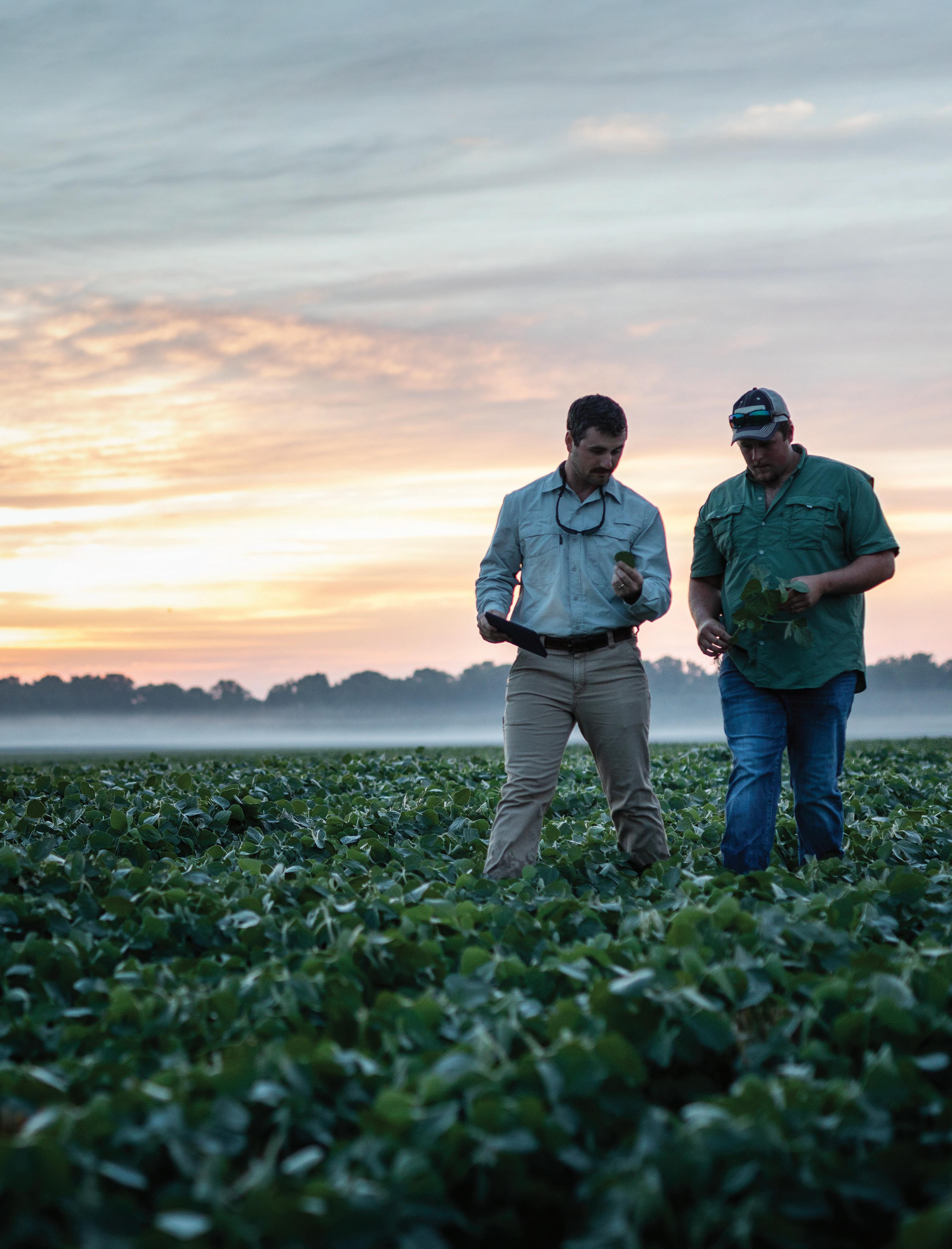























Whether you’re dealing with drought, flood, heat or other climate-related stress, the soy checkoff is working behind the scenes to diversify U.S. soybean genetics and increase stress tolerance. We’re looking inside the bean, beyond the bushel and around the world to keep preference for U.S. soy strong. And it’s helping make a valuable impact for soybean farmers like you.
See more ways the soy checkoff is maximizing profit opportunities for soybean farmers at unitedsoybean.org

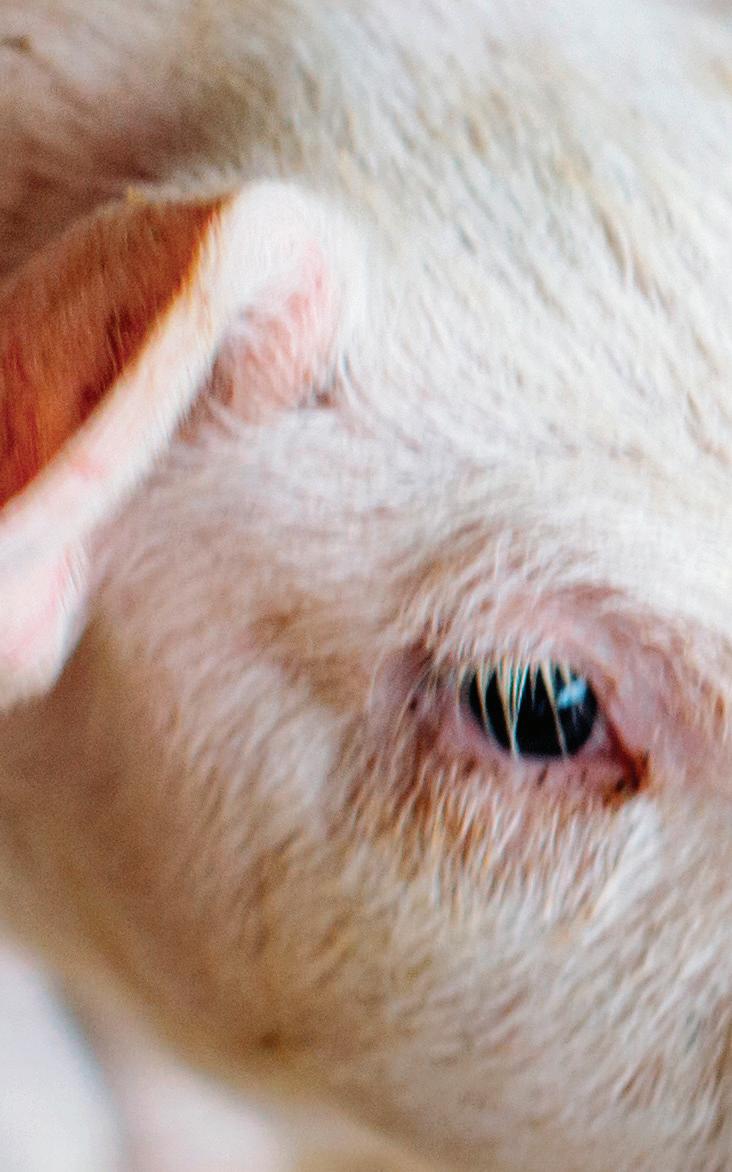
A new meta-analytical study reinforces U.S. Soy’s reputation for being a global leader in quality and nutrient density. The study showed that U.S. Soy has higher sucrose levels, a balanced amino acid profile, higher digestibility, increased metabolizable energy and lower fiber content. These traits mean that U.S. Soy will continue to be a top choice for protein in the global market in the years to come. Read more about this study on pages 18-19.
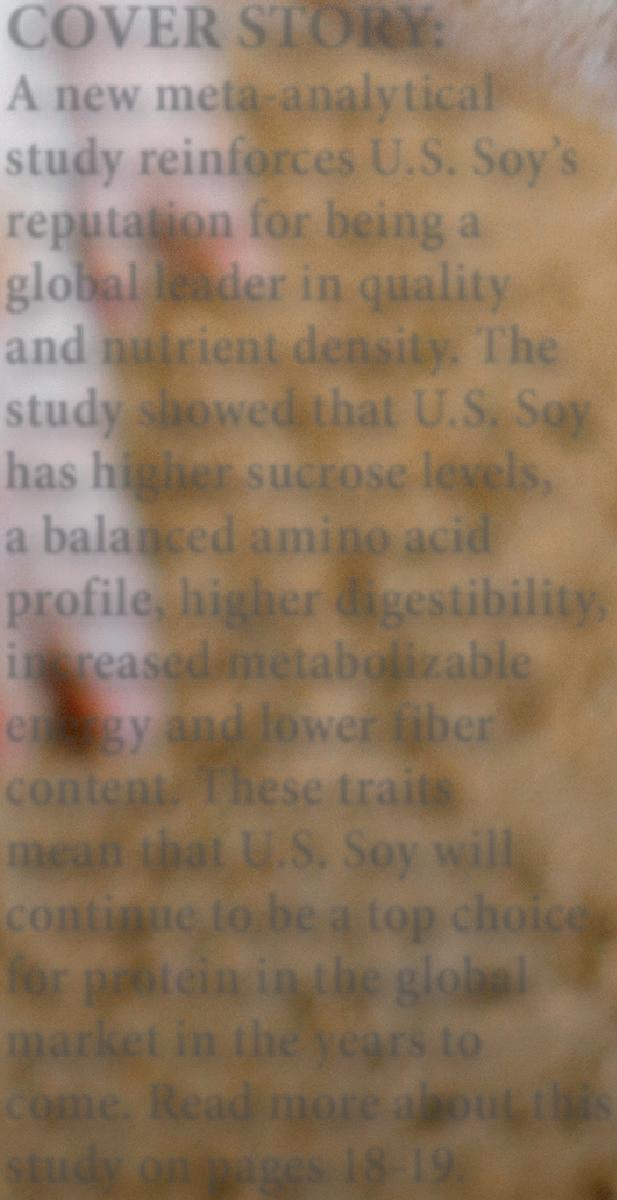



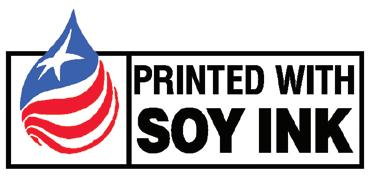
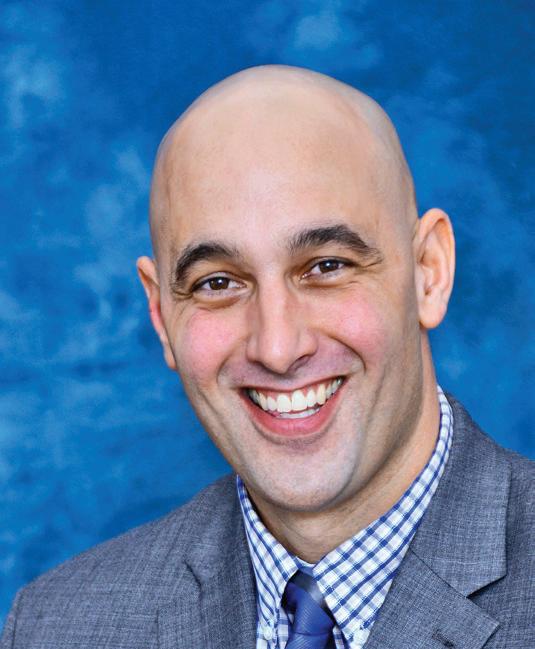
Ohio Soybean Association President Marion County soybean farmer
It is hard to believe it has been over a year since the initial farmer meetings for H2Ohio took place. Since then, a lot has changed in our world but one thing that remains consistent is Ohio farmers’ dedication to protecting water quality.
Since last year’s meetings, over 1 million acres of farmland have been enrolled in the H2Ohio program and Governor Mike DeWine has announced his plans to include more H2Ohio funding in the 2021 biannual budget. As I write this letter, the fi rst round of payments recently went out to 154 farmers in Northwest Ohio for Voluntary Nutrient Management Plans. The H2Ohio program is part of many years of hard work by the Ohio Soybean Association and our partners to ensure that new water quality policies are science-based and practical.
If you are one of the nearly 2,000 farmers who is currently enrolled in H2Ohio, please do not forget to enroll in the Ohio Agriculture Conservation Initiative (OACI) Farmer Certification Program before March 31. You must be enrolled in both H2Ohio and OACI to receive your funding. Visit OhioACI.org to enroll or search for OACI on the App Store or Google Play.
If you are not in the 14 H2Ohio counties, you can still enroll in OACI’s Farmer Certification Program and take your operation’s conservation and soil health to the next level with a free nutrient management analysis. OACI is 100 percent free and is administered by the Ohio Federation of Soil and Water Conservation Districts. To enroll in the OACI Farmer Certification program, visit OhioACI.org or download the app from the Apple App Store or Google Play Store.
While you are online enrolling in OACI, take some time to renew your membership with the Ohio Soybean Association.
You can do so at www.soyohio.org/membership. Your membership is vital to the success of our organization and allows us to continue to advocate for programs like H2Ohio that will support Ohio’s soybean industry for generations to come.
 Ryan Rhoades OSA President
Ryan Rhoades OSA President
Marion
CountyPresident
Ryan Rhoades, Marion County
Vice President
Patrick Knou , Shelby County
Treasurer
Rusty Goebel, Williams County
Secretary
Jennifer Wilson-Oechsle, Van Wert County
Chairman
Scott Metzger, Ross County
Trustees
Jerry Bambauer, Auglaize County
Trish Cunningham, Union County
Bret Davis, Delaware County
Justin Esselburn, Holmes County
Caitlyn Heimerl, Industry A liate Ex-O cio
Je Magyar, Ashtabula County
Je McKanna, Hancock County
Derek Reusser, Holmes County
Andy Stickel, Wood County
Bob Suver, Clark County
Kerrick Wilson, Preble County
American Soybean Association
Board Representatives
Jerry Bambauer
Bret Davis
Scott Metzger
Staff Credits
Kirk Merritt - Publisher
Julia Brown - Editor
Brent Warren - Art Director
Barry Falkner - Photo Quality/Proofer
Ohio Soybean news is published six times a year by the Ohio Soybean Association, 918 Proprietors Rd., Suite A, Worthington, OH 43085. Phone: 614-476-3100. For address corrections contact Ohio Soybean News at 918 Proprietors Rd., Suite A, Worthington, OH 43085.
Web address: www.soyohio.org E-mail: cdeboard@soyohio.org
Comments and statewide news articles should be sent to the above address. Advertising space reservation must be made by the rst of the month preceding publication. In consideration of the acceptance of advertisement, the agency and the advertiser must, in respect of the contents of the advertisement, indemnify and save the publisher harmless against any expense arising from claims or actions against the publisher because of the publication of the content of the advertisement.
For Advertising Sales Contact:
Matt Herman - (612) 812-5833
matt.herman@dtn.com



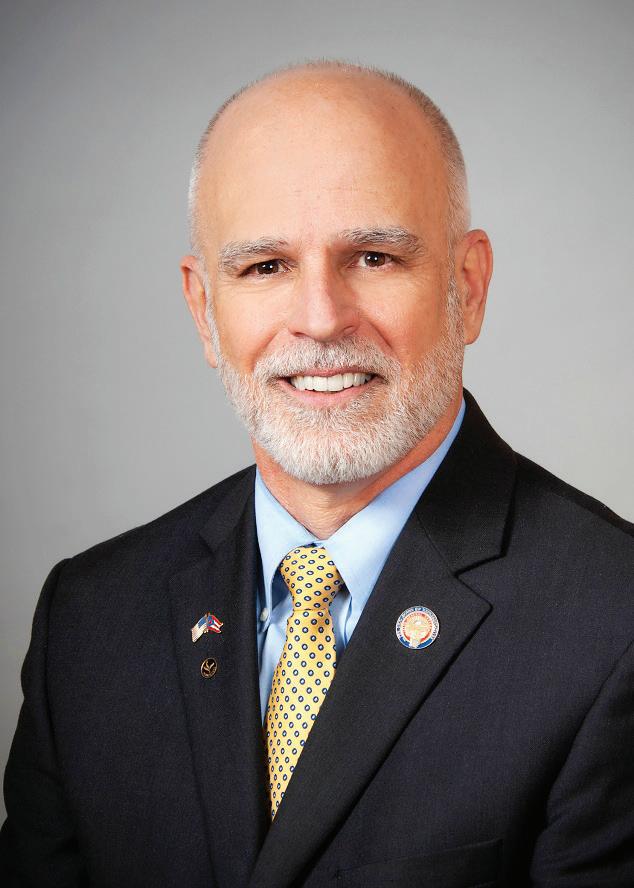
The beginning of 2021 marked the start of the 134th General Assembly and with it a change in leadership with Senator Matt Huffman elected as President of the Senate and Representative Bob Cupp re-elected as Speaker of the House. There were a few shake ups in committees, with leadership changes to the Senate Agriculture and Natural Resources committee and the addition of a committee in the Ohio House that will address infrastructure and rural development. Here's the rundown:
Senator Tim Schaffer
Chair, Senate Agriculture & Natural Resources
A public servant since 2000, Senator Schaffer has worked in both the Ohio House and Ohio Senate. During his time in each chamber, he has chaired several committees, but this will be his first time leading the Senate Agriculture and Natural Resources Committee. Schaffer is quoted saying, “Agriculture is a vital industry in my district and throughout Ohio and it is critical that we protect our natural resources. I look forward to addressing any issues or concerns in these crucial areas of our economy."
He represents the 20th Senate district which encompasses Fairfield, Guernsey, Hocking, Morgan and Muskingum counties, as well as parts of Athens and Pickaway counties.

Representative Kyle Koehler
Chair, House Agriculture & Conservation
Returning as Chair for his last term in the Ohio House, Representative Kyle Koehler was selected to lead the House Agriculture and Conservation Committee. Koehler has served on this committee since his first term in office and has chaired it since the 133rd General Assembly. He is native of Springfield, Ohio, and runs a small business with his family.
Representative Reggie Stoltzfus
Chair, House Infrastructure & Rural Development
Representative Reggie Stoltzfus is currently serving his second term in the Ohio House of Representatives. He represents the 50th House District, which includes the eastern portion of Stark County. He owns and operates several local businesses, employing around 40 people. Rep. Stoltzfus resides on a small farm in Paris Township with his wife and four children.
Senator Bob Peterson
Chair, Senate Energy & Public Utilities No stranger to agriculture, Senator Bob Peterson was named the Chair of the Senate Energy & Public Utilities Committee. He is an 8th generation farmer and farms with his family in Fayette County. He represents the 17th Ohio Senate District, which encompasses

Clinton, Fayette, Gallia, Highland, Jackson, Pike and Ross counties as well as portions of Lawrence, Pickaway and Vinton counties. In addition to leading the Energy and Public Utilities Committee, he will also serve as a member of the Senate Agriculture and Natural Resources Committee.
Representative Jason Stephens
Chair, House Energy & Natural Resources
Representative Jason C. Stephens is serving his first term in the Ohio House of Representatives after being appointed in the 133rd General Assembly. He serves the 93rd House District, which includes Jackson and Gallia Counties, as well as portions of Lawrence and Vinton Counties. Stephens has an extensive background in local government, most recently serving as Lawrence County auditor. He previously served as Lawrence County commissioner. Stephens is a small business owner as well. He currently is a licensed insurance agent at Stephens & Son Insurance Agency, Inc and is a co-owner of Stephens & Son Insurance of Chesapeake, Inc.
Senate Agriculture & Natural Resources
Chair - Tim Schaffer (R-Lancaster)
Vice Chair - Stephen Huffman (R-Tipp City)
Ranking Minority Members - Teresa Fedor (D-Toledo)
Bob Hackett (R-London)




Tina Maharath (D-Canal Winchester)
Sandra O'Brien (R-Rome)
Bob Peterson (R-Washington Court House)
House Agriculture & Conservation
Chair - Kyle Koehler (R-Springfield)
Vice Chair - Rodney Creech (R-W. Alexandria)
Ranking Member - Juanita Brent (D-Cleveland)
Brian Baldridge (R-Winchester)
Adam Bird (R-Cincinnati)
Sarah Arthur Fowler (R-Rock Creek)
Paula Hicks-Hudson (D-Toledo)
Joseph Miller (D-Amherst)
Michael O’Brien (D-Warren)
Don Jones (R-Freeport)
Darrell Kick (R-Loudonville)
Jena Powell (R-Laura)
Michael Sheehy (D-Oregon)
House Infrastructure & Rural Development
Chair - Reggie Stoltzfus (R-Paris Township)
Vice Chair - Bill Dean (R-Xenia)
Ranking Member - Richard Brown (D-Canal Winchester)
Willis Blackshear (D-Dayton)
Rodney Creech (R-W. Alexandria)
Thomas Hall (R-Middletown)
Mark Johnson (R-Chillicothe)
Mike Loychik (R-Cortland)
Riordan McClain (R-Upper Sandusky)
Adam Miller (D-Columbus)
Joseph Miller (D-Amherst)
Michael Sheehy (D-Oregon)
Nino Vitale (R-Urbana)
Senate Energy & Public Utilities
Chair - Bob Peterson (R-Washington Court House)
Vice Chair - Kirk Schuring (R-Canton)
Ranking Minority Member - Sandra Williams (D-Cleveland)
Andrew Brenner (R-Powell)
Jerry Cirino (R-Kirtland)
Hearcel Craig (D-Columbus)
Matt Dolan (R-Chagrin Falls)
MTeresa Fedor (D-Toledo)
Frank Hoagland (R-Mingo Junction)
Rob McColley (R-Napoleon)
Bill Reineke (R-Tiffin)
Mark Romanchuk (R-Ontario)
Steve Wilson (R-Maineville)
House Energy & Natural Resources
Chair - Jason Stephens (R-Kitts Hill)
Vice Chair Brian Stewart (R-Ashville)
Casey Weinstein (D-Hudson)
Sedrick Denson (D-Cincinnati)
Gary Click (R-Vickery)
Brett Hillyer (R-Urichsville)
Darrell Kick (R-Loudonville)
David Leland (D-Columbus)
Mary Lightbody (D-Plain Township)
Mike Loychik (R-Cortland)
Craig Riedel (R-Defiance)
Scott Wiggam (R-Wooster)
Finance Subcommittee on Agriculture, Development & Natural Resources
Darrell Kick (R-Loudonville)
Jean Schmidt (R-Loveland)
Reggie Stoltzfus (R-Paris Township) u
embership is the key to the Ohio Soybean Association (OSA) policy and legislative efforts. Through OSA’s representation at the state and federal levels, we promote and encourage growth and profitability of the soybean industry. Membership is available to soybean producers, industry members and anyone else who advocates for the growth of the industry.
Where does that leave younger soybean advocates? Students and young adults are still passionate about the industry but may not know how to get involved.
The OSA Student & Young Adult Membership Program is specially designed for younger advocates. This program is open to anyone between the ages of 18 to 24 interested in advocating
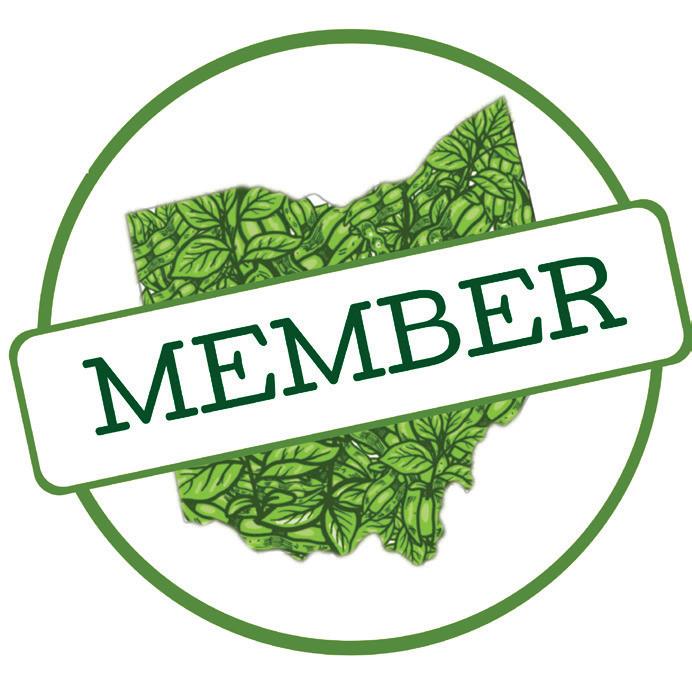
for the soybean industry.
Membership in the Student & Young Adult Membership Program offers a variety of benefits, including subscriptions for updates on the soybean industry, professional development opportunities, and of course, state, and
federal advocacy representation. This three-year membership is available at no cost to those who join.
Student & Young Adult members can continue their membership after graduation and once they turn 25 years old, can take advantage of the 50% discount OSA offers on one- and threeyear memberships. Anyone who was previously a member of OSA’s Student & Young Adult program, can get their first one-year membership to OSA at $40 or three-year membership for $100.
Are you or someone you know interested in joining as a Student or Young Adult member? Visit soyohio. org/membership and click “Join Today.” It takes less than 5 minutes to become a member. Sign up today to support the soybean industry as a young advocate. u
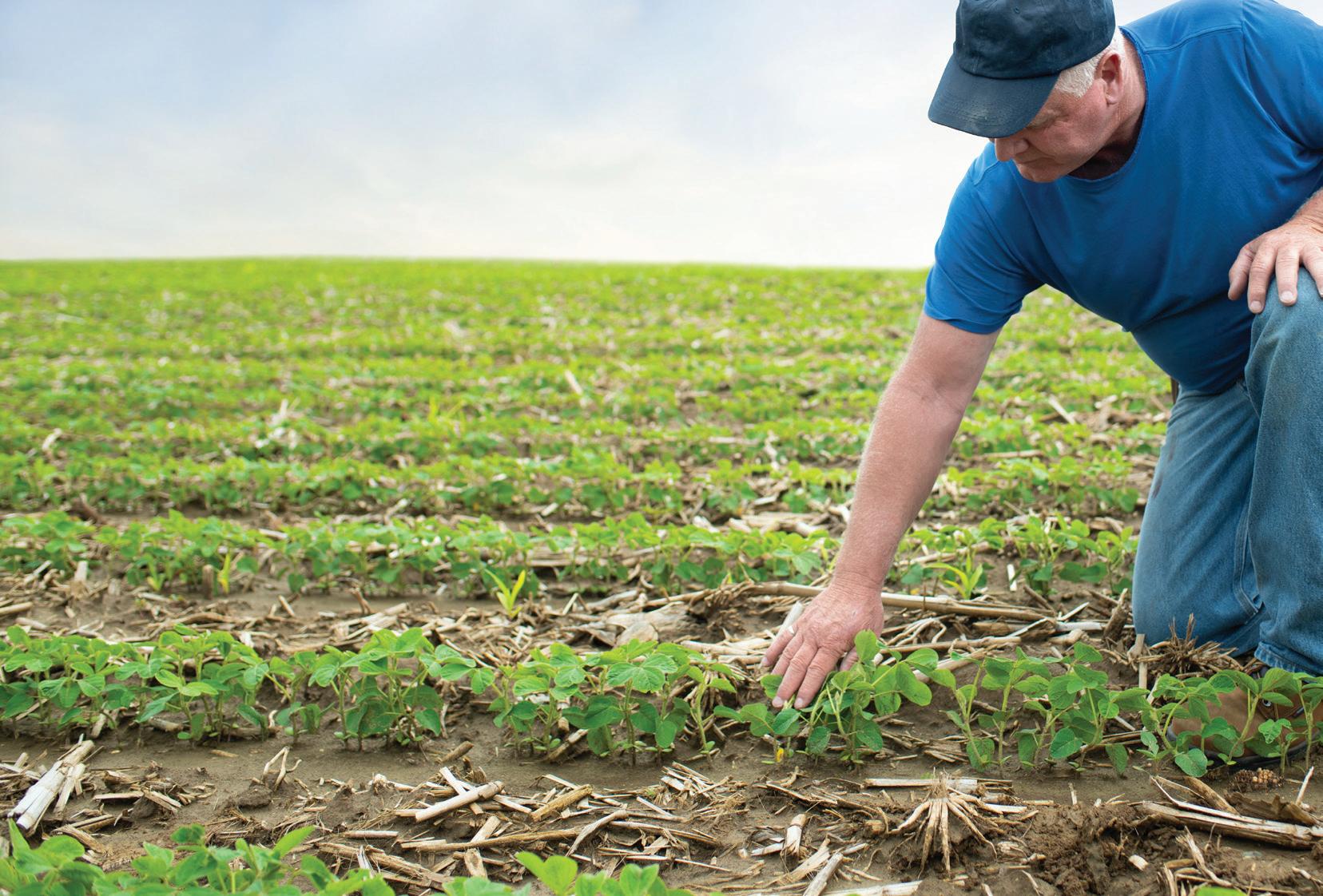



The recent rally in the soybean market has been a welcome change. The average farm price for soybeans for the past five years is 27% lower than the five prior to them. The downward movement in prices was amplified starting in 2018 with trade friction with China coupled with the outbreak of African Swine Fever in the country. As trade tensions lessened and China’s hog herd recovered, the global Covid-19 pandemic struck. However, the situation has improved and demand for U.S. soybeans skyrocketed as South America ran out of beans to export. This resulted in the nearby soybean futures price rising from around $8.50 per bushel to almost $14.40 per bushel (Figure 1). Despite the economic philosophy that a rising tide lifts all boats, the rally occurred during a point in the marketing year that severely lessened producers’ abilities to fully realize the higher prices.
The biological delay between planting soybeans in the spring and harvesting in the fall creates price risk for producers. Decisions are made and costs incurred at planting based on what is known at that point. However, prices can move substantially before the crop can be harvested and sold. Part of the solution to this problem of risk is to lock in prices before harvest through legally binding contracts. While pre-sales in the U.S. are not regularly tracked by any public source, a couple of surveys provide a snapshot of their utilization. One[1] found that among Midwestern grain farmers, 26.9% use option puts, 24.5% used futures markets and 69.1% used forward contracts. Note that these sum to more than 100%, as more than one can be used by a producer. Both futures markets and forward contracts lock in a specific price. This protects against a price drop but also prevents price increases from being realized. Another survey of corn producers,

primarily in Illinois, found that 41% of corn production was already priced by July 1 through forward or futures contracts. Unfortunately, the soybean price rally didn’t start until late August, so any of the crop sold before harvest wouldn’t have realized the higher prices.
In addition to providing the nearby futures price, Figure 1 also shows the net commercial positions in the Chicago Mercantile Exchange soybean market. This data is released weekly by the Commodity Futures Trading Commission (CFTC). The commercial traders are anyone with a hedging position, i.e., those who have a stake in the physical commodity. This includes producers, merchants, processors and soybean users and excludes speculators. Even if a farmer doesn’t use a futures contract to pre-sell, an elevator that has agreed to buy the crop in a forward contract may hedge its position in the futures market, which would show up in this data. The net position is purchases (longs) minus sales (shorts). A negative value indicates more sales than purchases. A more negative commercial net position can loosely be thought of as more sales tied to the physical commodity, soybeans in this case. As can be seen in the chart, sales tend to be highly correlated with the price. Unsurprisingly, as the price rises, so does the volume of sales. When prices fall, sales also go down.
However, 2020 had a slightly different pattern. Sales through the summer were quite high, likely because soybean stocks were large and storage was needed for a crop that was expected to be large at that time. Starting in late December, commercial net long positions started dropping as prices kept increasing. Prices are
a signal to supply more and consume less. It appears that producers were unable to supply more at this time, indicating that much of the soybean stocks were already committed. Interestingly, this phenomenon emerged as soybeans struck $12 per bushel, hinting that producers have had limited sales above that amount.
Likewise, USDA sales data indicate much of the soybean crop has already been sold. After the completion of the September through August marketing year, USDA releases the percent of the annual sales by month. The sale is recorded in the month the crop is delivered, not the month in which it was contracted. However, the price recorded by USDA is the sale price, not the current market price. For this reason, USDA monthly farm prices can lag the cash markets.
Table 1 shows the cumulative percent of reported sales of U.S. soybeans by producers. For example, in the 2010/11 marketing year 75.4% of the crop had been delivered by the end of January and 80.9% by the end of February, indicating that 5.5% of the year’s total was delivered in February. The column on the far right shows the average across the past 10 marketing years. Over this period, 53% was delivered by the end of December and 67% by the end of January, indicating that two thirds of the soybean crop has left
1:
CumulativepercentofU.S.producersoybeansales Marketingyear
2010/112011/122012/132013/142014/152015/162016/172017/182018/192019/2010yearavg SEP11.03.811.75.75.37.76.47.46.55.97.1 OCT41.627.634.032.532.631.538.033.825.925.232.3 NOV49.036.442.745.746.439.050.445.838.336.543.1 DEC58.244.952.057.757.148.759.654.548.548.653.0 JAN75.459.967.974.070.560.876.467.961.860.567.5 FEB80.971.075.082.578.367.281.777.568.264.974.7 MAR85.379.780.087.883.476.784.983.873.969.980.5 APR88.285.684.391.586.885.787.188.178.373.584.9 MAY91.088.690.293.789.390.489.790.883.177.188.4 JUN94.192.893.895.994.095.092.694.089.285.192.7 JUL97.196.897.798.197.697.797.097.295.093.296.7 AUG100.0100.0100.0100.0100.0100.0100.0100.0100.0100.0100.0
producers’ possession at this point, on average. Keep in mind that since the numbers are for contracted but undelivered beans, they represent the minimum percent of the crop that is priced at that point.
September through December implied soybean use for the United States is at a record level. Figure 2 divides that implied level for the first quarter by total use for the crop year. This indicates that 38% of the 2020 crop was used in the first quarter. The orange line overlays the percent sales through December from Table 1. The sales (deliveries) for the first quarter are highly correlated with the use. Using a simple linear regression for the 2010 to 2019 time period and the January WASDE projected ending stocks for 2020/21, first quarter sales for the 2020/21 marketing year are estimated to be 55%, which is above the 53% 10year average pace. As a result, less than 45% of the soybean crop is expected to

have been unpriced at the beginning of 2021 before prices reached their peaks. Unfortunately, it is not possible with these data to determine how much less.
While the recent rally in soybean prices has been helpful to producers, its timing has presented limited opportunities for them to capitalize on it. Surveys show that most producers use tools to lock in prices and that much of the corn crop is already pre-sold in the middle of the growing season. USDA data indicates that much of the crop had already been delivered before the price peak was reached. CFTC data implies that sales tied to physical soybeans were also falling off in the midst of the rally. The January WASDE has the projected season average price received by producers at $11.15 per bushel, but that would require an average price received by farmers of $12.60 per bushel for January through August based on the 10-year average sales pace. Evidence indicates that sales were already slowing down before prices reached those levels. While prices for the new crop in 2021 are up, the November contract is $2.15 per bushel less than the nearby March contract. Unfortunately, not all boats will float higher with the rising tide. u
[1] Coffey, B.K. and Schroeder, T.C. (2019), “Factors influencing Midwestern grain farmers’ use of risk management tools”, Agricultural Finance Review, Vol. 79 No. 2, pp. 192-203. https://doi.org/10.1108/ AFR-04-2018-0026


The Ohio Soybean Association (OSA) applauds Gov. Mike DeWine’s investment of $100 million for the Ohio Department of Agriculture’s share of the H2Ohio program in his recently announced budget proposal. These funds will
nutrient runoff and help protect water quality for all Ohioans.
“We thank Governor DeWine and his team for their commitment to farmers as we continue to prioritize water quality,” said OSA President and Marion County soybean farmer Ryan Rhoades. “So far, the

help farmers in the Western Lake Erie Basin continue to implement best management practices that prevent

H2Ohio program has been successful in promoting the best practices for nutrient management on over a million acres of
Average Income: $40 per hour
Meetings & Preparation: 10 hrs. / $400
Legislative Tracking & Analysis: 10 hrs. / $400
Virtual Farm Tours: 8 hrs. / $320
Total Time & Cost: 28 hrs. / $1,120
Membership (3YR) = $205
Total Savings = $915
As members, you get free policy & issue updates and notifications. Gaining access to these services through other means can be costly. OSA & ASA have a team that are dedicated to monitoring legislative activity to act quickly on issues to advocate for soybeans
Zoom fatigue is real, not just for farmer members, but legislative staff too. OSA uses tools & strategies, like our virtual farm tours, to make remote advocacy engaging.
farmland and we look forward to building on that success in the coming years.”
The H2Ohio phosphorus reduction plan has focused first on reducing runoff into the Maumee River Watershed and Lake Erie and will eventually be offered to other parts of the state in the future. The original funding for the program was approved in 2019.
Additionally, the Governor’s proposed budget includes the following:
$7 million in addition to the $12 million allocated in the recent capital appropriations for the Farmland Preservation Program, which will permanently preserve farmland through the purchase of agricultural easements from landowners
Over $250 million toward expanding broadband access and infrastructure u
$1.65 MFP on 2.5 acres of land with a 48 bu/acre average yield = One 3YR membership to OSA @ $205
Due to poor planting conditions, Ohio's average soybean yield was down significantly in 2019. Still, if you were able to secure the $1. 65 MFP payments for just 2.5 acres of land with a 48 bu/acre average yield, that paid for the $205 cost of becoming a three-year OSA member.










Whether it’s improving soybean meal to outperform the competition or promoting the sustainability of U.S. soy, the soy checkoff has been working behind the scenes to help farmers satisfy their customers’ needs. We’re looking inside the bean, beyond the bushel and around the world to keep preference for U.S. soy strong. And for U.S. soybean farmers like you, the impact is invaluable.
See more ways the soy checkoff is maximizing profit opportunities for farmers at unitedsoybean.org
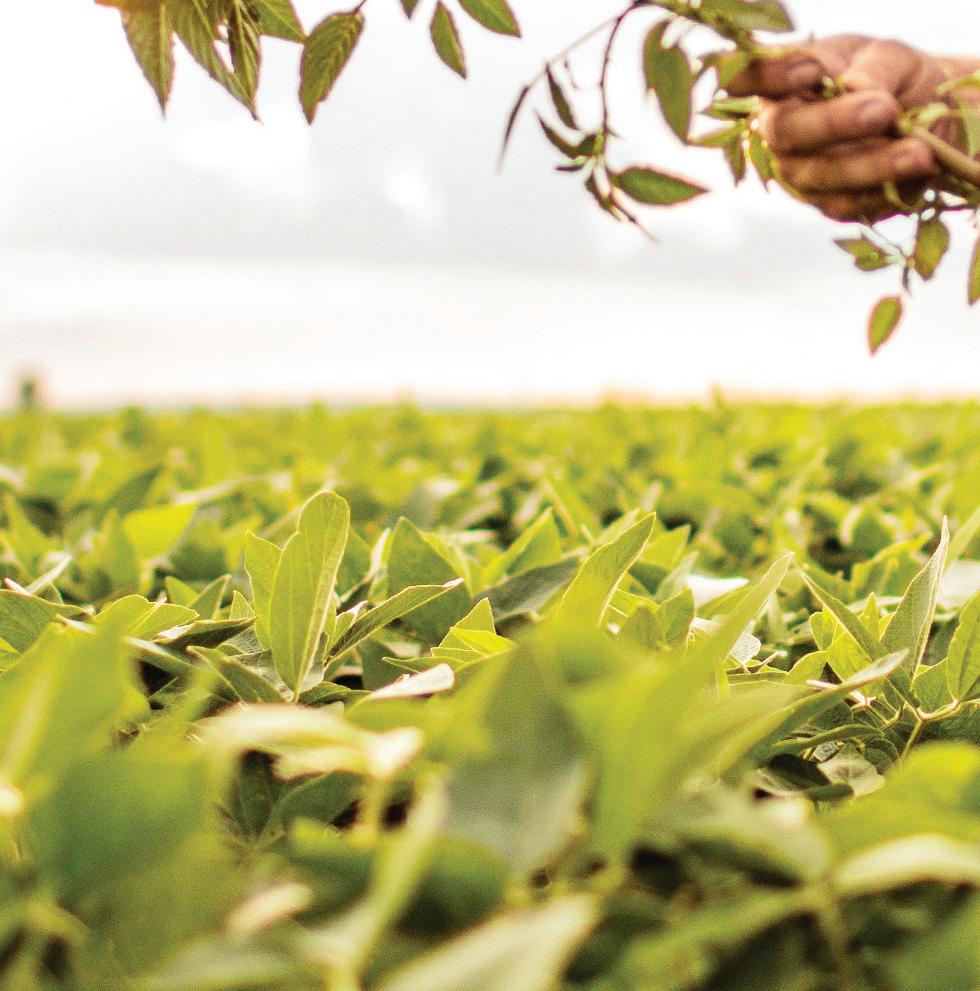







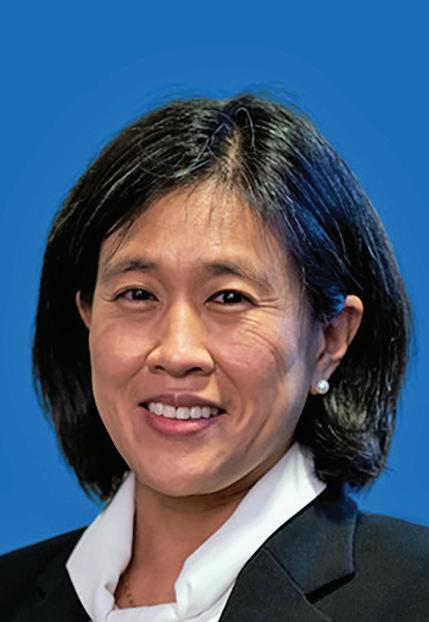

Michael Regan
Administrator, Environmental Protection Agency
Most Recent Position: Secretary of the N.C. Department of Environmental Quality
Experience: During his time at the North Carolina Department of Environmental Quality, Regan oversaw regulatory and public assistance programs aimed at protecting the quality of North Carolina’s air, water and land, its coastal fisheries, and the public’s health. He has more than 18 years of experience focused on environmental advocacy and regulation, serving as the Associate Vice President of U.S. Climate and Energy and Southeast Regional Director of the Environmental Defense Fund. He also worked with the Environmental Protection Agency under the Clinton and Bush administrations on air quality and energy programs. Regan founded M.Regan & Associates, LLC, a firm dedicated to helping organizations find transformational solutions to complex energy, environmental and economic challenges.
Notes: When confirmed,
Regan will be the first African American man to run the EPA. Biden has made climate change a top priority for his administration, so the head of the EPA will be a primary player in achieving those goals.
Regan has said protecting drinking water and working for environmental justice should be priorities of the EPA.
Photo: North Carolina EPA website
Tom Vilsack
Secretary of Agriculture
Most Recent Position: CEO of the U.S. Dairy Export Council
Experience: Vilsack previously served as the Secretary of Agriculture during both terms of the Obama administration.
He is also a former governor of Iowa. During his confirmation hearing with the Senate Agriculture committee, he shared that climate could provide market opportunities for farmers and must be designed to ensure that the principal beneficiaries are farmers. He also acknowledged that the best approach for farmers will be voluntary, producer-led, and incentive based.
Notes: Vilsack was chosen for his experience with farmers and rural communities. He is the safe choice for Biden
after disagreements within the Democratic party on who should lead.
Photo: By Bob NicholsKatherine Tai
U.S. Trade Representative
Most Recent Position: Chief Trade Counsel for the House Committee on Ways and Means
Experience: During the Obama administration, Tai was a senior member of the Office of the General Counsel for the U.S. trade representative and was responsible for China trade enforcement issues.
Notes: When confirmed, she will be the first woman of color to hold this position.
Tai has received praise for her skills and experience from many in the Democrat party. Ohio’s Sherrod Brown tweeted, saying: “Katherine Tai is the most qualified candidate for USTR, and her nomination would reflect President-elect Biden’s commitment to the Dignity of Work. Ms. Tai played a critical role in securing real improvements for workers in the [United StatesMexico-Canada Agreement] last year.” Biden has said that getting “us back on the same page with our allies” will be a
priority for the beginning of his presidency.
Photo: The White House
Pete Buttigieg Secretary of Transportation
Most Recent Position: Mayor of South Bend, Indiana
Experience: In 2020, Buttigieg ran for president in the Democratic primaries, but withdrew and endorsed Biden. He was an intelligence officer in the U.S. Navy Reserve and deployed to Afghanistan in 2014. He is also a former Rhoades scholar.
Notes: When confirmed, he would be the first openly LGBTQ person in U.S. history to have a permanent Cabinet role. Biden's transition website says he will work to “create millions of good, union jobs rebuilding America's crumbling infrastructure — from roads and bridges to green spaces and water systems to electricity grids and universal broadband — to lay a new foundation for sustainable growth, compete in the global economy, withstand the impacts of climate change, and improve public health, including access to clean air and clean water.” u
Photo: Gage Skidmore



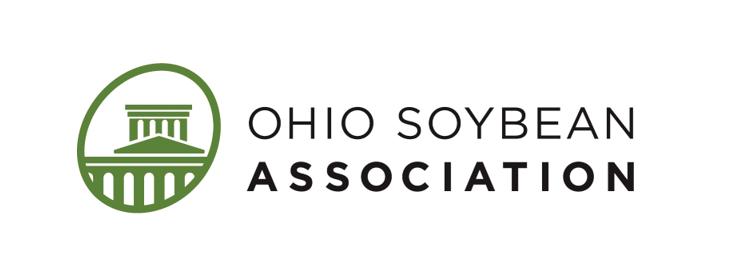
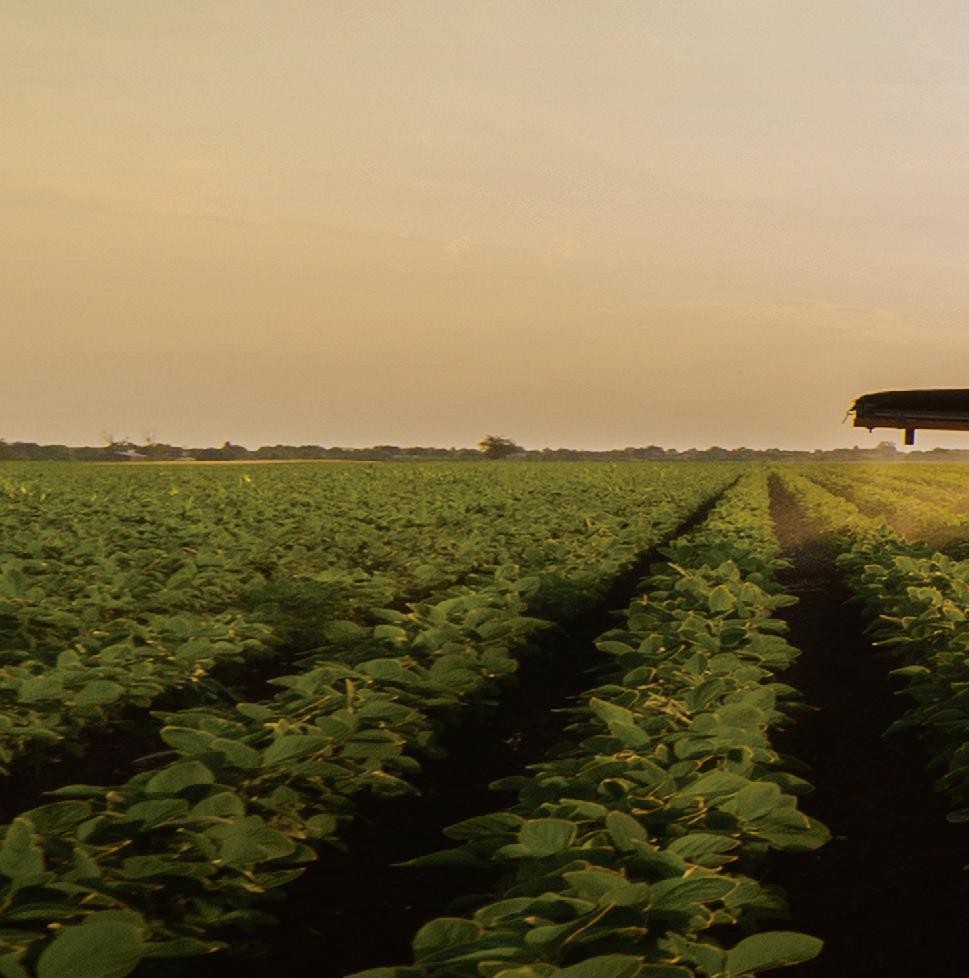










Farmers wishing to improve the health of their soils are often presented with a list of specific management practices to implement.
“There are many types of management to combine to manage soil health,” said Jordon Wade, from the University of Illinois at Urbana Champaign. “These typically include: keeping the soil covered, minimizing soil disturbance, keeping plants growing throughout the year, having a diversity of plants, and incorporating livestock.”
Wade was a recent speaker for Ohio State’s “The Dirt on Soil Health” series featuring a discussion findings from his research looking at the relationship between improving soil health and increasing yields. As farmers evaluate their soils, there are three areas to assess.
“When making an assessment, the three indicators we look at are physical, chemical, and biological,” Wade said. “Not all fields respond the same. The practices implemented to improve soil health are impacted by outside factors such as climate, geology, the duration of time since implementation, and the soil texture. Ultimately the outcomes farmers are looking for are soils that have high plant productivity, provides physical support, cycles nutrients, has good water movement, and filter potential pollutants.”
When considering the research, a question that needs to be answered is, “How well does the assessment connect to the outcomes?”
“We wanted to learn how soil health indicators connect to yields and determine if healthy soils produce greater yields than less healthy soils,” Wade said. “We investigated if
biologically active soils produce greater yields than less active soils?”
To answer these questions, Wade and his team at the University of Illinois at Urbana Champaign studied replicated nitrogen (N) rate trials on non-irrigation fields for corn systems at 30 sites in five states. The N trials were layered with soil health practices, such as cover crops including: barley, rye, clover, or bare ground. They considered tillage, which included the use of: chisel, moldboard plow, and no-till. They also had various crop rotations, such as: continuous corn, corn-soybeans, corncorn-soybean, and corn -corn-corn-soybean, and corn-soybean- wheat, and corn-wheat. Some fields also had a history of manure being used. Many of these activities were layered and overlapped. All these factors were considered and measured statistically. In the study, there were a good range of healthy soils and a good representation of values.

in a standard soil test. It also looked at soil protein, which is N rich. After compiling all the data, the research team went through a process to determine which factors were most important.
The nature of the study looked for differences within and between fields.
“This study measured soil health,” Wade said. “Soil health is not directly measured with just one factor. It is comprised of multiple variables.”
One factor is POXC.
“POXC can be understood as oxidation applied to organic matter that is part of the microbial food web,” Wade said. “Another factor is respiration, which basically shows how hard soil microbes are working.”
The research took into account the soil organic matter (SOM) measured
“We discovered that respiration was not providing unique information,” Wade said. “The other three factors were used in the final blended variable. For our purposes, soil health is a combination of POXC, soil organic carbon, and soil protein.”
Once the research defined the variable blend to be measured, it also evaluated the N applied. “The Preplant N and N rate were factored into the equation when determining yield,” Wade said.
All the factors were cross analyzed with each other to see which
influenced the others, and how they interacted statistically.
“In that process the pre-plant nitrate was not strongly related to yields,” Wade said.
The data did show that improving soil health improved overall yields.
“Improved soil health increased yields statistically,” Wade said. “The specific numbers varied by the field, however we can generally say that a 10% increase in soil health results in roughly a 5% increase in yields. We can also say that the proper use of N fertilizer increases soil health.
“What this means is that healthy soils are more productive. It also indicates that if farmers are using soil
health building practices, they have some cushion for N application. If there is a question about increasing the N rate or not, the increase in soil health will make up the difference, kind of like an insurance policy.”
Though trends could be identified, every field is different.
“The research looked at multiple fields, and multiple observations,” Wade said. “When the numbers were combined, the individual field observations tended to cluster together. The typical averaging results of all the fields combined together is not effective with soil health analysis.
“The question is if the relationship is consistent between soil health
and yield across the fields observed. The results found that as soil health improves, that yields also increase in general across fields.”
When trying to interpret soil health tests for N management, some basic guidelines should be followed.
“Farmers should be sampling at the same time of year and stay consistent by using the same lab for more uniform results,” Wade said. “Over time, a farmer should want the values of POXC and SOM and soil protein to be increasing. Soil health test results should be applicable for making N fertility decisions for up to 5 years after sampling.” u
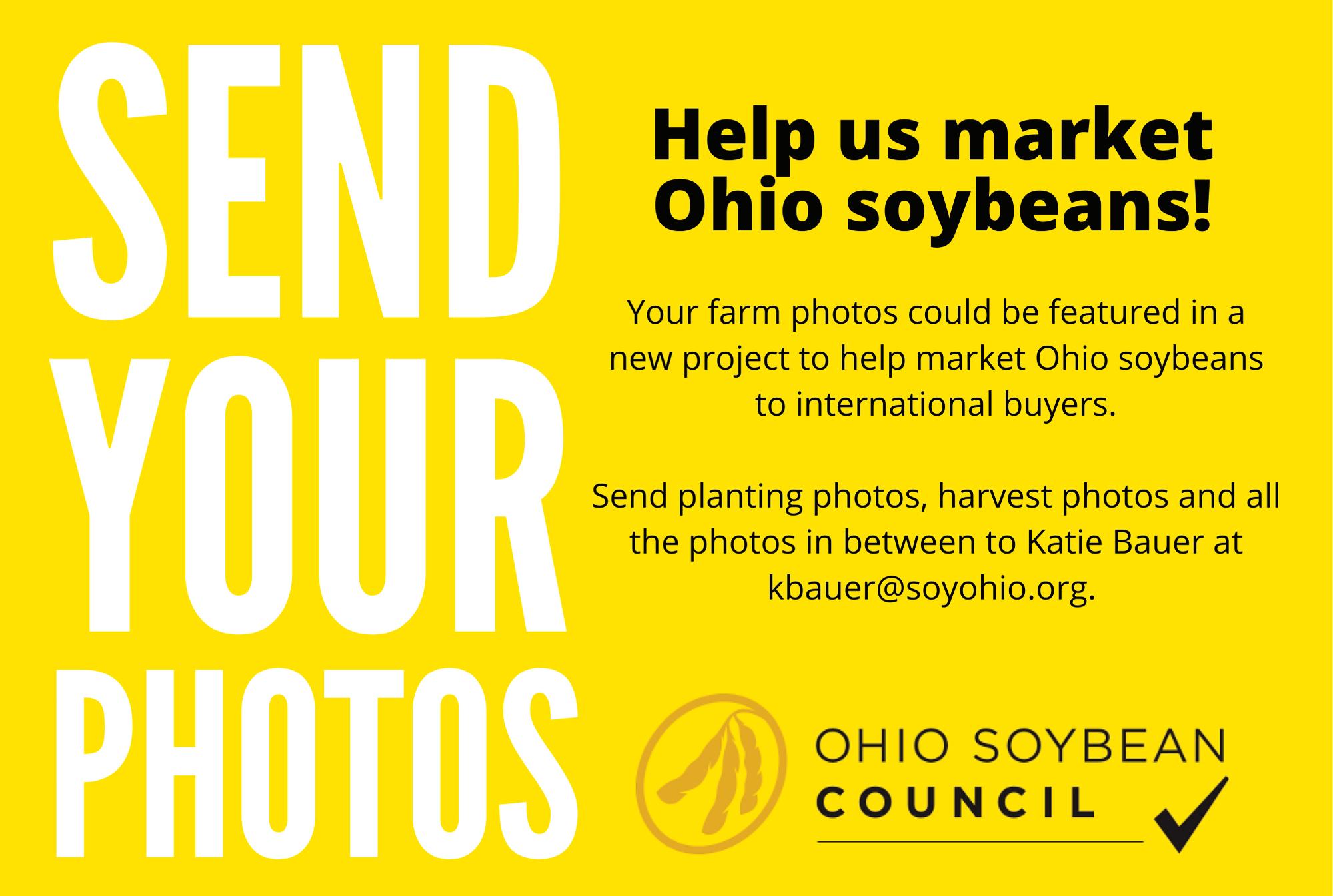







Rural roads and bridges serve as the initial link in the overall supply chain — allowing the soybeans and grain produced on a farm to be eventually consumed by both domestic and international customers. Of the bridges in the country classified as deficient and, in many cases, subject to closures or restricted access, a significant percentage are located in rural areas.
“Our nation’s rural bridges serve as the initial step in a lengthy journey to the ultimate customer,” explains Mike Steenhoek, executive director of the Soy Transportation Coalition (STC).
“Unfortunately, the region of the country in which bridge conditions are most severe — rural areas — also happen to be the region in which available funding to improve these conditions is stagnant or on the decline. The concern remains that if this starting line for farmers is not well-maintained, soybeans and grain will not effectively reach the finish line in delivering to our customers.”
Given the significance of this need and the limited resources to address it, a potential response by bridge owners is to simply close or restrict access to existing bridges or hope federal, state, or local government will be willing and able to supply the necessary revenue. While pursuing increased investment is appropriate and closing or placing restrictions on certain rural bridges may be prudent, increased energy and attention must be devoted to addressing the cost side of the equation and making existing tax dollars stretch further.
“We know that our infrastructure needs to be well-maintained in order for us to stay competitive in the market,” said Warren County soybean farmer David Clark, who also serves on the Soy Transportation Coalition and Ohio Soybean Council boards. “Investing checkoff dollars in research like this can help us identify priority areas where we can focus our time and energy.”
In the effort to promote more cost-effective approaches to replacing and repairing rural bridges without compromising safety, the STC has released the report, “The Top 20 Innovations for Rural Bridge Replacement and Repair.” The report features the following ten rural bridge replacement and ten rural bridge repair innovations.
Bridge Replacement Innovations
Railroad Flat Car Bridges
Geosynthetic Reinforced Soil — Integrated Bridge System (GRS-IBS)
Vibratory H-Piling Drivers
Buried Soil Structures
All Steel Piers
Galvanized H-Piling
Press Brake Tub Girders
Galvanized Steel Beams
Prestressed Precast Double Tees
Precast Inverted Tee Slab Span Bridges
Bridge Repair Innovations
Piling Encasements
Concrete Pier Piling Repairs
Driving Piling through Decks
Epoxy Deck Injections
Deck Overlays with Type O Concrete and Plasticizers
Deck Patching
Thin Polymer Concrete Overlays
Penetrating Concrete Sealers
Spot Cleaning Painting Steel Beams
Concrete Overlay on Adjacent Box Beams
“Many of the innovative concepts featured in this report can result in a 50% or greater cost savings for rural counties,” says Jonathan Miller, a soybean farmer from Island, Kentucky, and chairman of the Soy Transportation Coalition. “This can easily result in replacing a bridge for $100,000 to $150,000 compared to the prevailing method of $250,000 to $400,000. Farmers understand with their own operations that simply spending our way out of a problem will rarely be successful. We also need to embrace
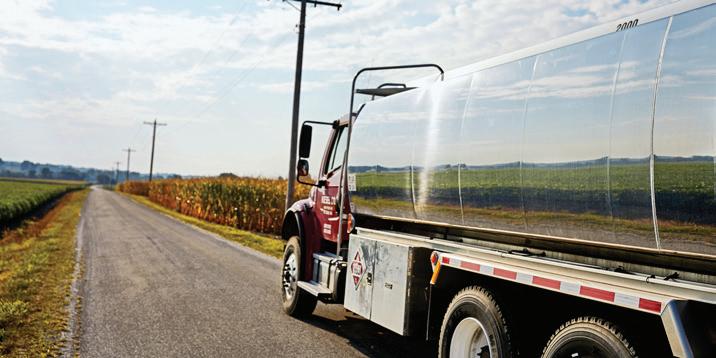
innovative ways to save our way out of a problem. This approach that works so well on the farm also applies to maintaining and improving our infrastructure.”
In order to select the featured innovative concepts, the STC assembled a group of 13 bridge engineers and experts from the 13 states that comprise the organization. Three engineers served as principal analysts for the project with the remaining ten engineers or experts serving as advisory committee members.
The innovative concepts for bridge replacement and repair featured in the project are not an exhaustive and comprehensive catalog. Numerous other innovative concepts exist and are worthy of being explored. The goal of the principal analysts and advisory committee members was to highlight a relatable number of innovative concepts that 1.) Will provide initial or lifecycle cost savings, 2.) Have been validated by a credible engineering entity or organization, and 3.) Are accessible in a large section of rural America. The featured bridge replacement and repair concepts reflect the broad consensus of the principal analysts and advisory committee members. Readers should not assume the bridge replacement and repair concepts featured in the above list are in complete alignment with the lists of each individual principal analyst or advisory committee member.
A document highlighting the innovate bridge replacement and repair concepts, expected cost and time savings, and links to validating research can be accessed at www.soytransportation.org



We all need a little help every now and again — especially when we’re trying to decide on a big purchase. From Angie’s List (for home repair providers) to Yelp (for local businesses) to Goodreads (for books), we rely on consumer reviews to help us choose the best way to spend our often limited resources.
Enter: Precision Ag Reviews, the soybean checkoff-funded site to help farms better understand and use precision ag technology.
We provide a space for farmers to share feedback with each other on the latest precision ag technology. From monitors to artificial intelligence to drones and beyond, we collect reviews from the people who use these products every day to make sure you have the information you need to choose the best tools.
Curious how you can use Precision Ag Reviews on your farm? Here are three ways to put this powerful resource into action:
#1 — Search the Precision Ag Reviews database.
Considering making a purchase but want to hear what other farmers thought first? Head on over to our extensive database of farmer reviews and drill down by category, subcategory and product name to explore feedback from those who have put that tool to the test.
Each product in the Precision Ag Reviews database includes:
An overall product rating based on reviews submitted
Average ratings in the areas of cost, ease of use, value and support
A product description, manufacturer details, and tutorials (where available)
Individual farmer reviews, including their perception of cost, ease of use, value and support
#2 — Submit a review on the precision technology you use! Like many things in life, you get out of it what you put in — and that’s where we need your help! Precision Ag Reviews is most useful when farmers like you share about their experiences. What did you like? What didn’t you like? How much support did you have in implementing that piece of tech on your farm? Head over to the PrecisionAgReviews.com website and write a review of your tech today. Want to grow the database even faster? Challenge your farmer friends to add their own feedback and insights, as well!
#3 — Learn about the latest products and approaches in the precision tech space.
In addition to farmer insights, Precision Ag Reviews publishes regular blog posts and the Precision Points Podcast. Each week, we feature perspectives and updates about precision ag technology, research and what experts believe is on the horizon for our farms.
Make sure to follow us on Facebook and Twitter, plus subscribe to Precision Points in your favorite podcast player, to stay up to date on the latest news and information.
Don’t wait for your neighbor down the road to share what they thought of the latest software or GPS equipment — explore, contribute and learn with Precision Ag Reviews today! u







Anew meta-analytical study reinforces U.S. Soy’s reputation for being a global leader in quality and nutrient density. The summary of this study is below.
CHEMICAL COMPOSITION, PROTEIN QUALITY AND NUTRITIVE VALUE OF COMMERCIAL SOYBEAN MEALS PRODUCED FROM BEANS FROM DIFFERENT COUNTRIES: A METAANALYTICAL STUDY
Soybean meal (SBM) is the primary source of protein for the feed industry worldwide, and it is an important protein source in livestock, poultry, and aquaculture diets. Among protein sources of plant origin, soybeans have the highest crude protein content, a balanced amino acid profile, and a high level of digestibility. Soybeans have become a top choice for protein and as such, they are strategically traded around the world. Soybean meal is the standard against which other protein sources are compared.
Understanding more about the chemical composition, protein quality, and nutritive value of commercial soybean meals enables us to better determine important agricultural outcomes.
A meta-analysis of eighteen different studies with 1,944 samples was performed by Ibañez et al. (2020) to quantify the relationship between country of origin of the bean and the chemical composition, protein quality, and nutritive value of the soybean meal. Soybeans from the following origins were evaluated: Argentina (ARG), Brazil (BRA), USA (USA), and India (IND).
Crude Protein. Crude protein (CP) is calculated by measuring the Nitrogen
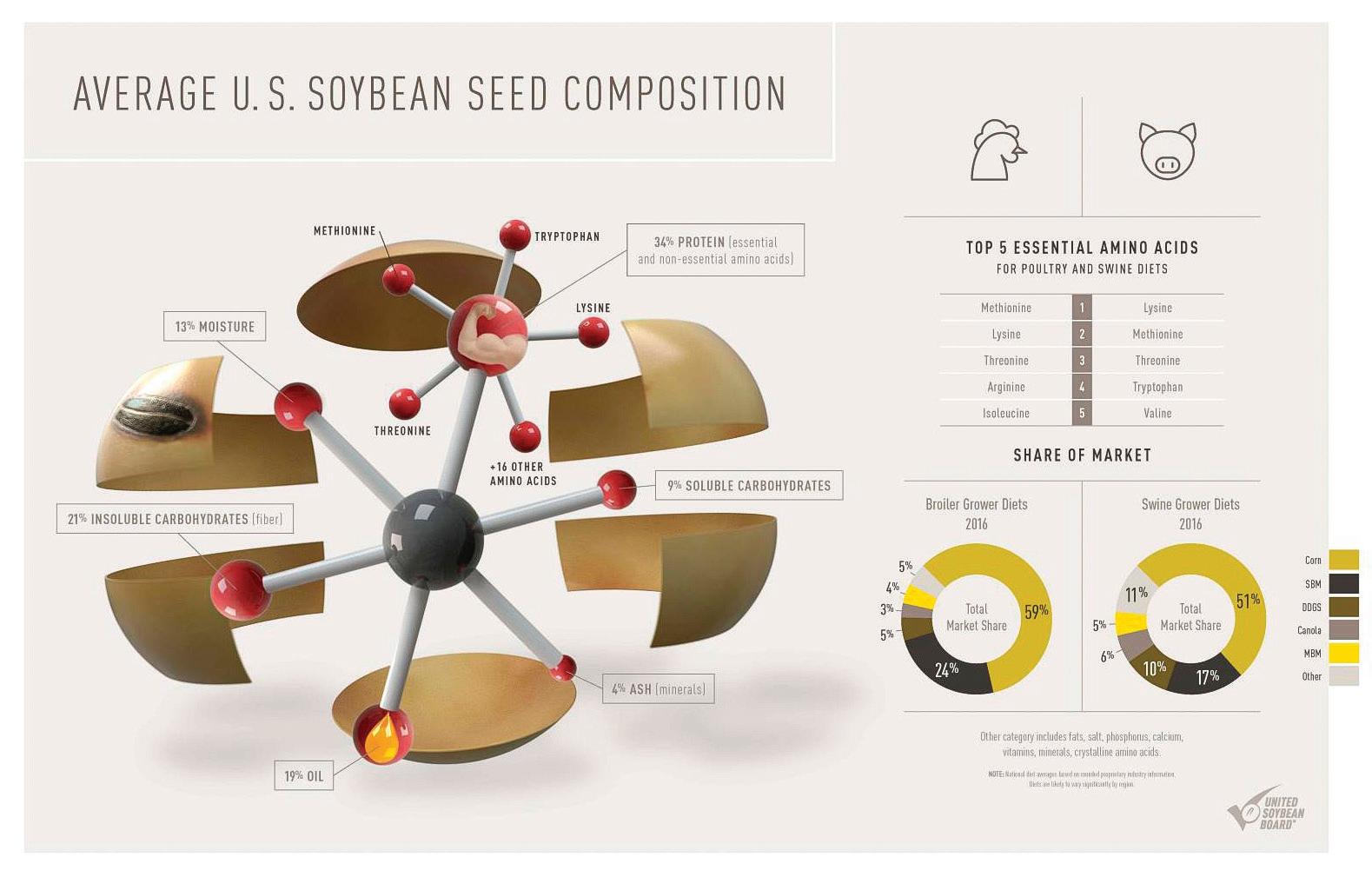
(N x 6.25) content of food. Higher levels of CP were found for BRA meals than for USA meals; CP was lowest for ARG. This is likely due to differences in seed genotype, planting area of the beans within countries, environmental conditions during the growing and harvesting seasons, and crop year.
Crude protein content and amino acid (AA) profile might also be dependent on latitude as research indicates soybeans grown closer to the equator have higher CP content and less Lysine, Methionine, and Threonine per unit of CP for soybean meal.
Crude Fiber & Neutral Detergent Fiber. Both Crude Fiber (CF) and Neutral Detergent Fiber (NDF) are measurements that quantify fiber content. Fiber is defined as the indigestible but partially fermentable component of feed. Both CF and NDF were higher for BRA and IND meals than for USA and ARG meals, consistent with most published research. As a highly palatable feed, soybean meal is characterized by
Data from a recent study suggest that the chemical composition, protein quality and nutritional value of soybean meal depend on the country of origin of the bean. The study also found that U.S. soybean meal had better protein quality traits than beans from other countries.
having a high protein content and a low CF content.
Sugars. Soybeans contain nearly as much carbohydrates as they do protein. The carbohydrates in soybean meal consist of free sugars, oligosaccharides, some starch, and non-starch polysaccharides. Of particular importance is the disaccharide sucrose. Sucrose is a highly digestible carbohydrate that when present in meal, increases the energy content and palatability of the feed. Sucrose was higher in USA and ARG soybean meals than BRA and IND soybean meals. In addition, oligosaccharides like stachyose were higher for USA and ARG than BRA and IND soybean meals while raffinose was lower. Though
indigestible in non-ruminant species, oligosaccharides might be fermented in the large intestine and when fed in limited quantities, they may have prebiotic properties with benefits on health and growth.
Amino Acid Profile. Amino acids (AAs) are subunits that make up proteins. They are critical for animal function and are responsible for the growth and development of an organism from building muscles and regulating the immune system to generating hormones and neurotransmitters. There are 20 AAs that comprise the genetic code. These can be arranged in an infinite number of combinations to create functional proteins. Out of these 20 AAs, there are ten that animals cannot make. Animals can recycle some AAs to build new proteins but other AAs such as Lysine, Methionine, and Threonine are only be obtained through feed. Soybeans have ten essential and ten non-essential AAs. (Essential AAs: Arginine, Histidine, Isoleucine, Leucine, Lysine, Methionine, Phenylalanine, Threonine, Tryptophan, and Valine; Non-essential AAs: Alanine, Asparagine, Aspartic Acid, Cysteine, Glutamine, Glutamic acid, Glycine, Proline, Serine, and Tyrosine). Soybean meal is cost effective in supplying essential AAs and has very good Lysine content and digestibility. Soybean meal is also ranked high Threonine digestibility. Soybean meals from USA and ARG had more Lysine, total Sulfur AA (sulfur-containing AAsàCysteine and Methionine), and Threonine per unit of protein than did BRA or IND.
Energy Content. The energy content of soybean meals depends on the content and the digestibility of the protein fraction and on the sucrose, oligosaccharide, and fiber content. Apparent Metabolizable Energy (AMEn) is used to generate energy values of soybean meals for feed formulation. AME is the gross energy of the feed consumed minus
the gross energy contained in the feces, urine, and gaseous products of digestion. The prediction equation is recommended by the World Poultry Science Association (WPSA; 1989), and is used by the industry, but the equation does not take into account the digestibility of the protein fraction, or the differences in sucrose and fiber content. As such, the equation is likely to under-evaluate the real contribution to energy of the USA meals.
Utilizing the recommended prediction equations by the WPSA, the AMEn of the BRA and USA soybean meals were similar in value, reflecting
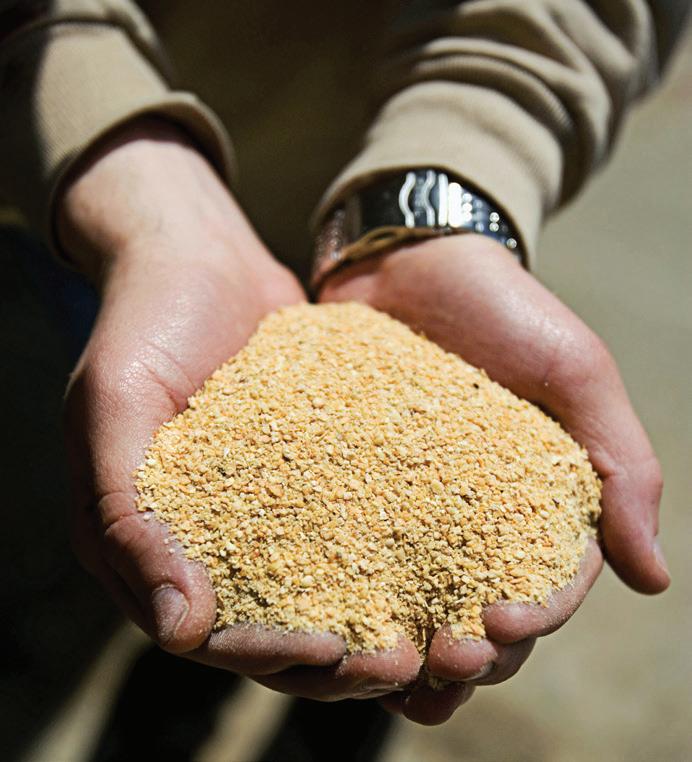
the higher CP but not the lower digestibility of the protein fraction and lower sucrose content of the BRA meals compared with the USA meals. In spite of having a lower CP content, the soybean meals from the USA had similar or even higher energy content for poultry and swine than the soybean meal from BRA, suggesting higher protein digestibility.
Protein Quality Profile (% per unit of protein). Protein quality refers to the digestibility and quantity of essential AAs. There are numerous ways to assess protein quality of a soybean meal sample, one of which is through Trypsin Inhibitors (TI) content. Trypsin Inhibitors are an
important group of antinutritional factors present in raw beans. Trypsin inhibitors prevent protein digestion, often leading to digestive disturbances, but in general, they are not a major issue in traditionally processed soybean meal (solvent or extruded) due to temperature, pressure, and time thresholds in processing (overcooking = low to no TI; undercooking = high TI). Procedures to measure TIs are costly so indirect methods are often utilized to measure them and include:
Urease Activity (UA) — Urease is a metalloenzyme that catalyzes the hydrolysis of urea to ammonia and CO2. High UA is undesirable in most cases (ruminant vs. poultry). In most cases, UA was below the threshold recommended for high quality meals for all SBMs, being highest for IND, but not reaching significance.
Protein Solubility in Potassium Hydroxide (KOH) — A solubility test used to evaluate heating processes. Results varied widely among origins with higher values for USA meals than ARG and BRA, and IND meals being intermediate (which might be indicative of less heat being applied to USA meals).
Protein Dispersibility Index (PDI) — This index compares the solubility of protein in water and it is an indicator of adequate heat processing of soybean meals. Results differed among origins with higher values for IND and USA meals than for South American meals.
Soybeans have excellent agronomic and nutritional qualities and soybean meal is one of the most important protein ingredients in animal diets today. With higher sucrose levels, a well-balanced amino acid profile, higher digestibility, increased metabolizable energy, and lower fiber content, quality traits are better for USA meals than those from the other origins. With growing demand for vegetable proteins, there will likely be an even greater demand for soybeans as the developing world becomes more affluent, adding overall value and demand for U.S. Soy. u




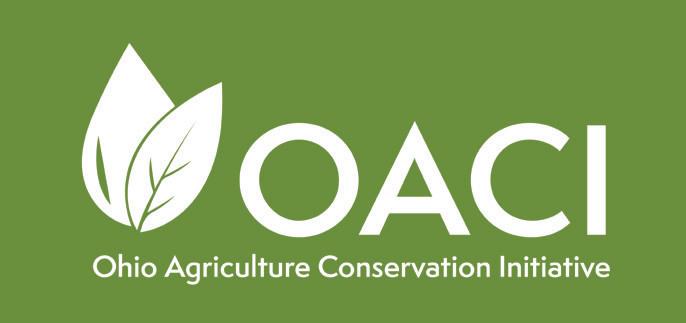
Enrollment is now live for the Ohio Agriculture Conservation Initiative (OACI) Farmer Certification Program, which will help farmers take conservation programs to the next level. Enrolling through the app or on OhioACI.org is easy and only takes a few minutes to complete!
1.Download the app (OACI Certifications) through the Apple App Store or Google Play Store. Or, visit OhioACI.org
a.On OhioACI.org, scroll down to the Farmer Certification Program and click ENROLL NOW
2.Click REGISTER and fill out the information needed to create an account, including:
a.First and last name
b. Username (Tip: set your email address as your username for an easy way to remember it for logging in)
c.Create a password and confirm the password
d.Select two security questions from the dropdown menu and provide the answer
e. Complete the CAPTCHA box
f. Click REGISTER
7. Once signed in, click on FARMER PROFILE on the left side of the screen. It will then prompt you to answer questions regarding general farm information, nutrient information, nutrient recommendations, and cost share.
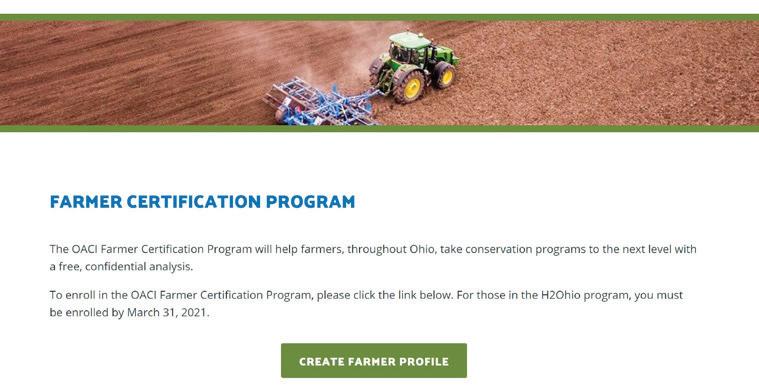


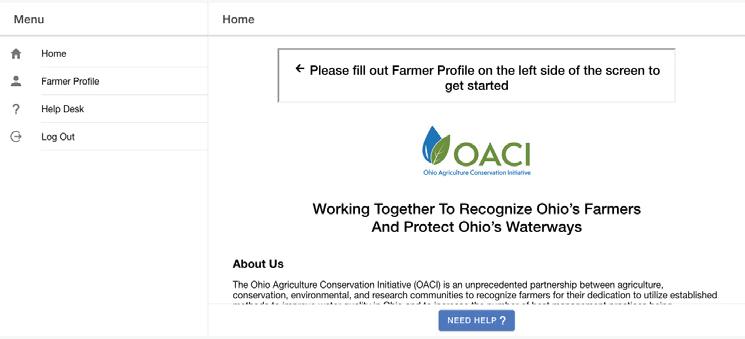
01 - GENERAL INFORMATION:
•Name
•Phone Number
•Username
•Farm Name
•Address
•County – select from dropdown menu under ‘Add County’ –you can add as many as needed
•Watershed(s) – select from dropdown menu under ‘Add Watershed’ or click on the blue ‘Don’t know your watershed, click here’
02 - FARM INFORMATION:
•Total Acres Farmed (Owned/Controlled; Rented)
•Acres Per Crop Rotation - If needed, click the green button to add another crop
03 - NUTRIENT INFORMATION:
•Nutrient Sources (Owned/Controlled; Rented) –Breakdown of Fertilizer, Manure, Biosolids and Other Acres
04 - NUTRIENT RECOMMENDATIONS*:
•NMP Complete (Yes or No. If no, has it been started?)
•FACT (Fertilizer Applicator Certification Training License) Complete (Yes or No. If yes, include date completed.)
•Nutrient Application on Frozen/Snow Covered Ground (Yes, No or I Don’t Know)
•Sensitive Areas (areas more susceptible for nutrient loss) Located and Mapped (Yes or No)
•Manure Storage (Dropdown menus to select species, amount of storage and type of manure)
05 - COST SHARE:
•Dropdown Menu of What Programs You are Currently Interacting With (CREP, CSP, EQIP, Other, Working Lands Program – may add multiple forms of cost share)
*Note: Where there is a blue circle with an ‘i’ on it, you can click on it for more explanation.
7.Any information missing will be listed on the bottom left. Once all required fields are completed, click SAVE.
CONGRATULATIONS! You are now enrolled in the OACI Farmer Certification Program. Please sign the form given to you with your H2Ohio contract and return it to nicole@ofswcd.org. After signing this page, please write in your name and county for easier verification. Watch for more information soon on the OACI Farmer Certification Program.
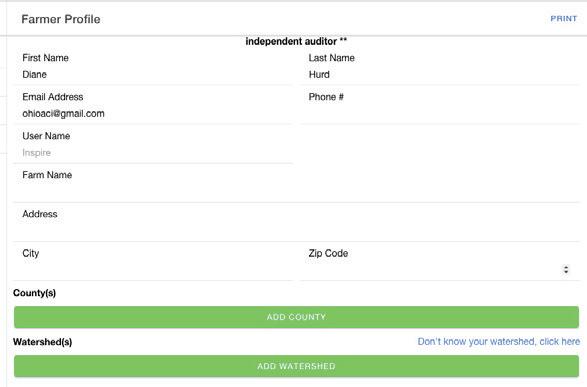


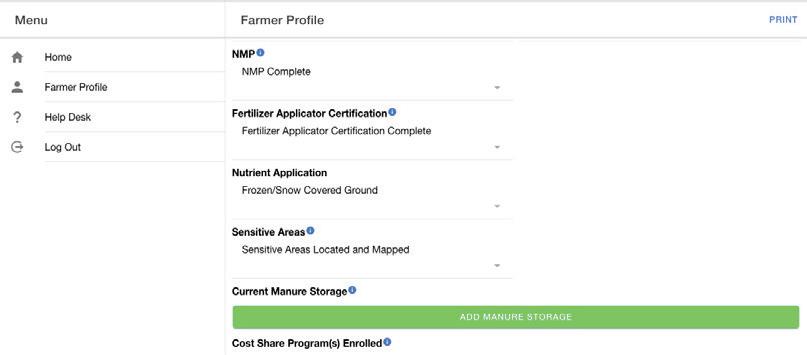
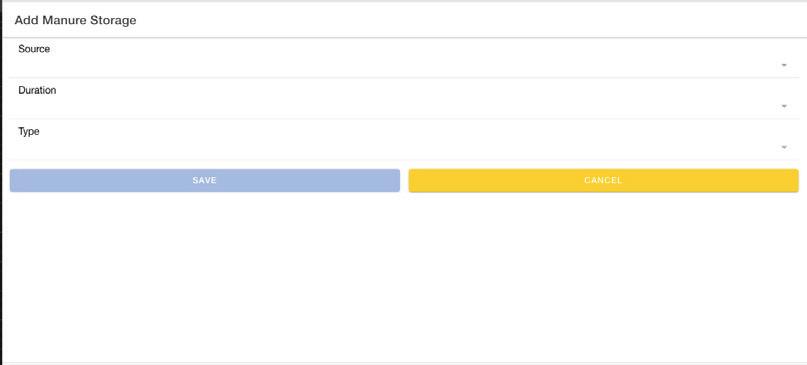

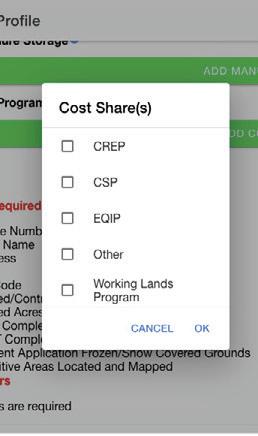
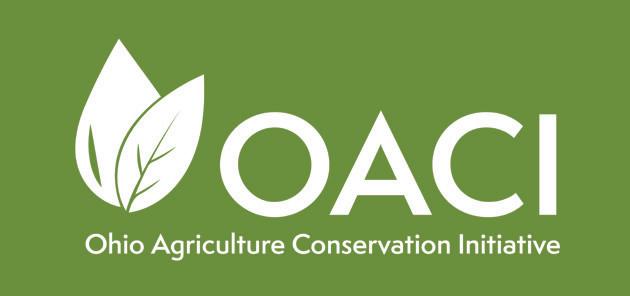







 By Donnell Rehagen
By Donnell Rehagen
ur industry has a vision to exceed six billion gallons by 2030 and with advancements in feedstocks, 15 billion gallons by 2050. The biodiesel and renewable diesel industry believes, with strong data, we will have the production and market development to reach this previously unimaginable goal by 2030. And, the good news is, we are already halfway there.
Ambitious industries need ambitious goals. Our nation needs us to be this ambitious. Since we announced our new industry Vision at the beginning of 2020, we have received questions from the industry and membership pressing us on how we came to six billion gallons by 2030.
As carbon policies around the country begin to take hold, we see tremendous opportunities for growth of low-carbon fuels like biodiesel, renewable diesel, and renewable jet fuel. While the volumes we envision may seem bold, the foundation we have built as an industry makes them attainable.
Through more than a year's-worth of discussions with industry experts and a deeply comprehensive analysis, we found there will be several key trends in the next ten years that will help us reach our lofty goals. Key driving factors include societal pushes for reduced carbon emissions; new technology; structural shifts in the petroleum sector; and the ability to meet carbon reduction goals with biomass-based diesel fuels as the lowest-cost option in the market.
Today there are more than 3 billion gallons of operating capacity online, with announced expansions potentially adding another 3+ billion gallons of capacity by 2024. This means our existing feedstock base will play a critical role. Currently soybean oil leads the way at nearly half the market with approximately 8 billion pounds of oil in 2019, which is approximately one-third of the soybean oil crushed in the U.S.
With our vision in mind, we are dependent on today’s and tomorrow’s farmers and oilseed processors. Our modeling suggests that a 6 billion gallon industry in 2030 will demand over 18 billion pounds of soybean oil each year.
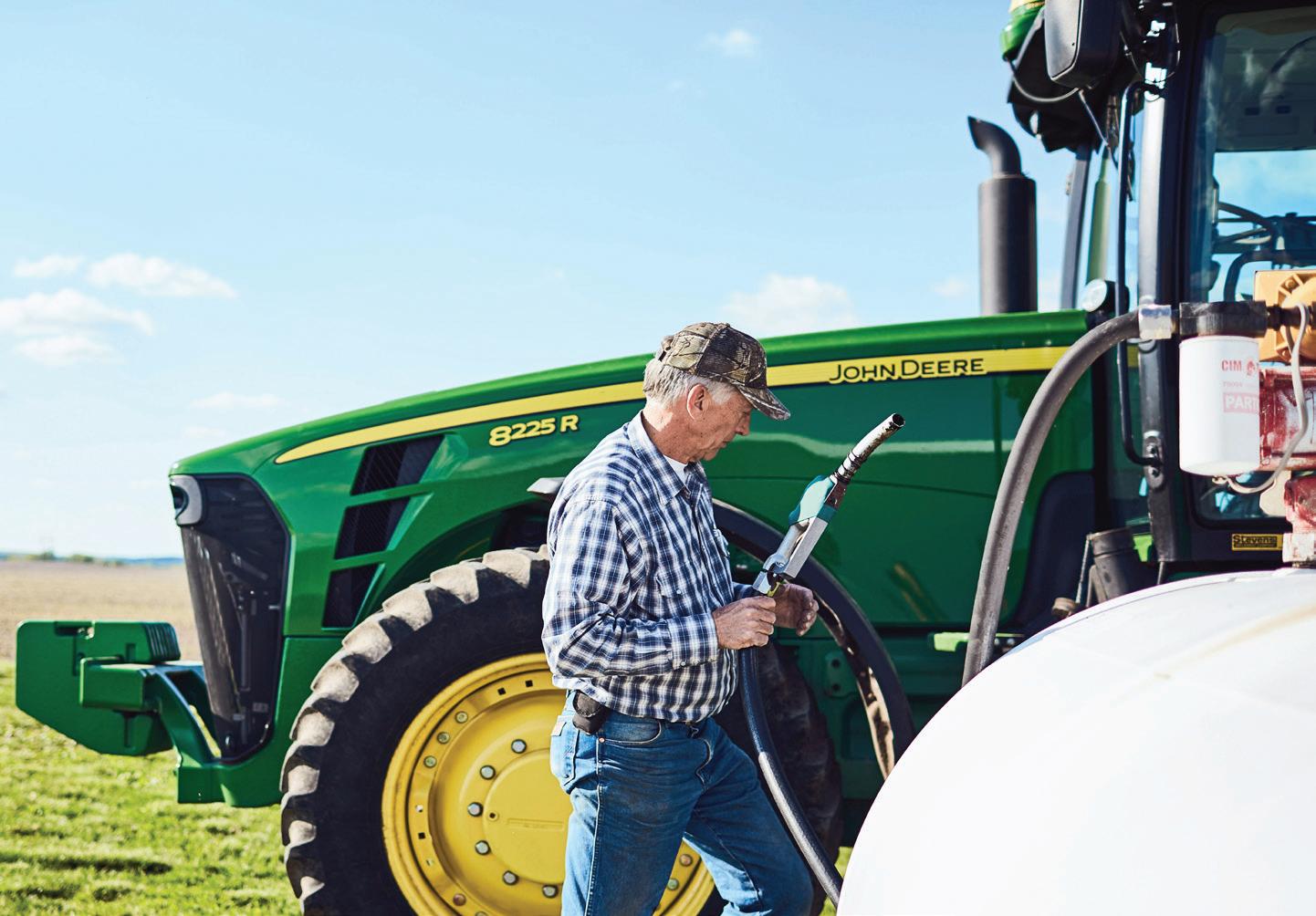
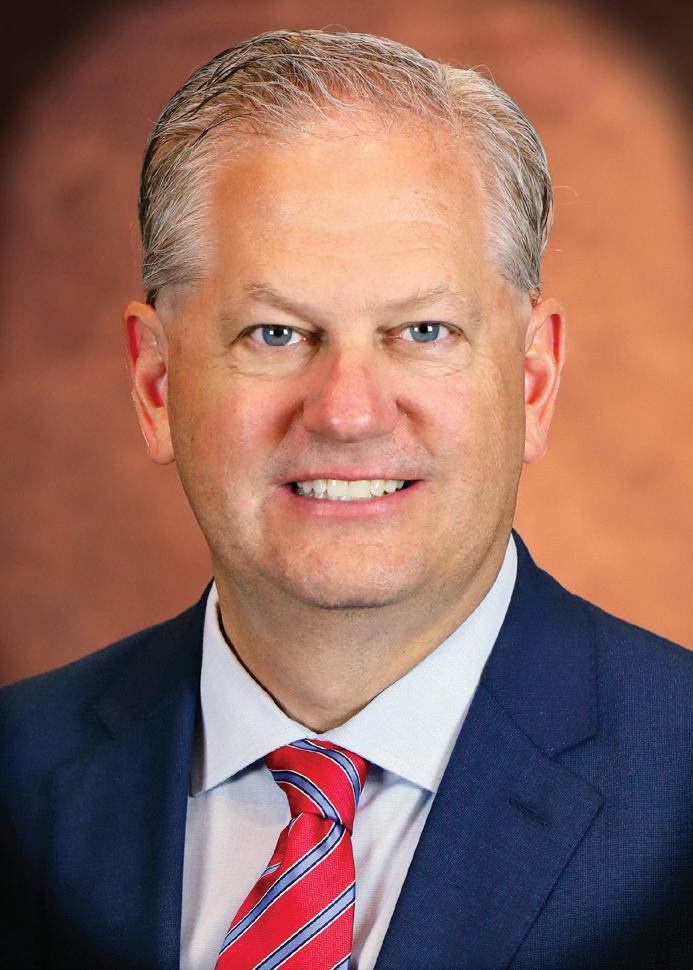
The continued growing demand for animal protein alone, driven by worldwide population growth, will lead to increased fats and oils in the market available for industrial uses. America’s — with Ohio playing a key role — farmers will continue to lead the way in feeding this growing population. And as more protein is demanded, more soybean oil will be available. Markets will adjust to these changing demand patterns. Bottom line, our industry will need way more soybean oil in the coming years, and Ohio’s farmers are well positioned to deliver for us.
Long-term, our sights are set on doing everything we can to promote, grow, and protect this valuable industry. We need all our industry partners to see and share our vision. Together with farmers, feedstock producers, oilseed processors, heating oil dealers, fuel distributors, and everyone throughout the supply chain, this industry is stronger and together we can reach 6 billion gallons by 2030 — and beyond. u


The American Society of Agricultural and Biological Engineers (ASABE) has named Bio-YIELD® from 3Bar Biologics winner of a 2021 AE50 award. AE50 awards honor the year’s most innovative designs in engineering products or systems for the food and agriculture industries. Companies from around the world submit entries to the annual AE50 competition and up to 50 of the best products are chosen by a panel of international engineering experts. The judges select innovative products that will best advance engineering for the food and agriculture industries.
Bio-YIELD, whose development was funded in part by the Ohio Soybean Council (OSC) and soybean checkoff, is a bioreactor device that enables farmers to grow their own beneficial microbes, allowing increased crop yield with reduced chemical inputs. This approach addresses one of the most significant sustainability challenges of our time: to increase agricultural production while reducing use of resources and impact on climate.
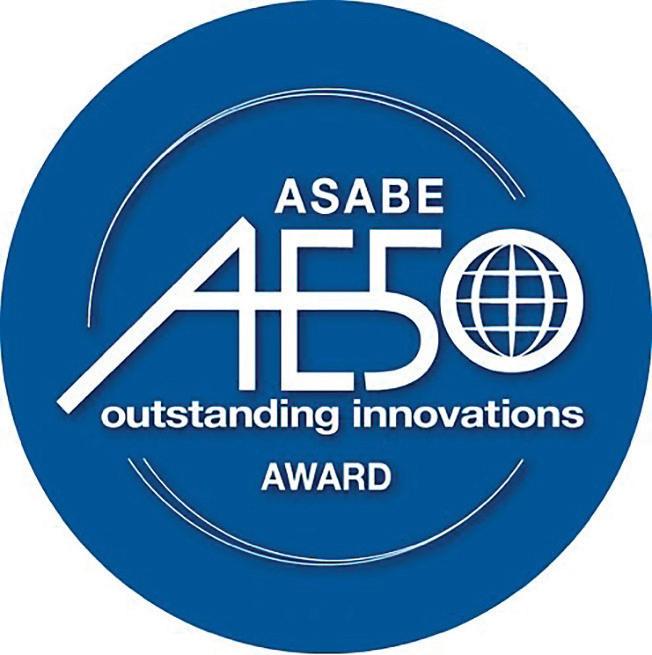
investment in technologies like BioYIELD continues to generate products that allow farmers to grow soybeans in a more environmentally conscious and profitable way.”
director of product development and commercialization. “Inoculants contain living organisms, which can be touchy — they normally require an experienced and delicate hand. With Bio-YIELD, farmers don’t have to moonlight as microbiologists to get optimal outcomes. OSC applauds our partner 3Bar Biologics, and if I may speak for 3Bar, we are all honored by ASABE’s recognition of Bio-YIELD and its role in the next generation of farming.”

“We are thrilled to see a technology that was funded with Ohio soybean checkoff dollars win such a prestigious and internationally recognized award,” said Todd Hesterman, OSC research committee chair and Henry County soybean farmer. “The checkoff’s
Agricultural inoculants, also known beneficial microorganisms, are applied in the field to promote plant health and growth. Most commercial inoculants are selected based on their ability to survive the delivery supply chain, rather than their in-field performance, which limits the system’s potential effectiveness. The Bio-YIELD bioreactor is activated on-farm, so it delivers fresher, more viable microbes than competitor processes. The system opens the commercialization potential of numerous beneficial, naturally occurring microbes that have been proven effective in laboratories but have never been available commercially in a viable state.
“Agricultural biologics have always been inconsistent,” explains Barry McGraw, OSC’s
The AE50 awards program emphasizes the role of new products and systems in bringing advanced technology to the marketplace. These engineering developments help farmers, food processors and equipment manufacturers increase efficiency, enhance quality, improve safety and increase profits.
To learn more about other checkoff-funded technologies being developed by the Ohio Soybean Council at Airable Research Lab, visit airableresearchlab.com u











“THE CHECKOFF HAS BEEN A HELP TO US. IT'S OPENED FOREIGN MARKETS AND FUNDED RESEARCH ON DISEASES AND FUNGI. THE RESEARCH AND DEVELOPMENT HAS JUST BEEN VERY POSITIVE.”
-JAN LAYMAN, KENTON, OHIO












BY INVESTING IN THE SOYBEAN CHECKOFF, FARMERS ENSURE END-USER DEMANDS ARE MET WHILE RAISING SOYBEANS PROFITABLY. USING INFORMATION FROM THE OHIO SOYBEAN COUNCIL, FARMERS TRACK RESEARCH ON NEW VARIETIES, NEW USES AND NEW FOREIGN MARKETS TO GROW NEW OPPORTUNITIES.
LEARN MORE AT SOYOHIO.ORG/HEREWEGROW.
BROUGHT TO YOU BY OHIO SOYBEAN FARMERS AND THEIR CHECKOFF.